The Family Medici: the Hidden History of the Medici Dynasty Pdf
| Medici | |
|---|---|
| Noble Business firm | |
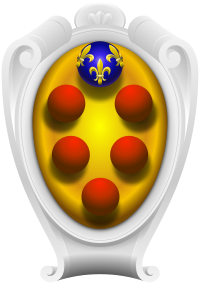 Glaze of arms of the Firm of Medici | |
| State | |
| Etymology | By Medico, Castellan of Potrone, considered the start ancestor of the business firm |
| Place of origin | Mugello, Tuscia (present-day Tuscany) |
| Founded | 1230 (1230) |
| Founder | Giambuono de' Medici[2] |
| Concluding ruler | Gian Gastone de' Medici |
| Final caput | Anna Maria Luisa de' Medici |
| Titles |
|
| Members |
|
| Continued families |
|
| Distinctions | Order of Saint Stephen |
| Traditions | Roman Catholicism |
| Motto | Festina lente [3] ("Hurry slowly") |
| Heirlooms | List
|
| Manor(southward) |
|
| Dissolution | 1743 (1743) (Original line) |
| Cadet branches | 14 cadet branches; however alive only 2: List
|
The Firm of Medici ( MED-i-chee,[4] Italian: [ˈmɛːditʃi]) was an Italian banking family and political dynasty that start began to assemble prominence nether Cosimo de' Medici, in the Republic of Florence during the showtime half of the 15th century. The family unit originated in the Mugello region of Tuscany, and prospered gradually until it was able to fund the Medici Bank. This bank was the largest in Europe during the 15th century, and it facilitated the Medicis' ascent to political power in Florence, although they officially remained citizens rather than monarchs until the 16th century.
The Medici produced four popes of the Catholic Church—Pope Leo X (1513–1521), Pope Clement 7 (1523–1534), Pope Pius 4 (1559–1565)[v] and Pope Leo Xi (1605)—and ii queens of France—Catherine de' Medici (1547–1559) and Marie de' Medici (1600–1610).[vi] In 1532, the family unit caused the hereditary title Duke of Florence. In 1569, the duchy was elevated to the Grand Duchy of Tuscany afterwards territorial expansion. The Medici ruled the Grand Duchy from its inception until 1737, with the death of Gian Gastone de' Medici. The k duchy witnessed degrees of economic growth under the early grand dukes, but was broke by the fourth dimension of Cosimo Iii de' Medici (r. 1670–1723).
The Medicis' wealth and influence was initially derived from the cloth trade guided by the wool guild of Florence, the Arte della Lana. Like other families ruling in Italian signorie , the Medici dominated their urban center's government, were able to bring Florence nether their family's power, and created an environment in which art and humanism flourished. They and other families of Italian republic inspired the Italian Renaissance, such as the Visconti and Sforza in Milan, the Este in Ferrara, the Borgia in Rome, and the Gonzaga in Mantua.
The Medici Banking company, from when it was created in 1397 to its fall in 1494, was one of the most prosperous and respected institutions in Europe, and the Medici family was considered the wealthiest in Europe for a fourth dimension. From this base, they acquired political power initially in Florence and afterwards in wider Italian republic and Europe. They were among the earliest businesses to use the full general ledger system of bookkeeping through the development of the double-entry bookkeeping organisation for tracking credits and debits.
The Medici family have claimed to take funded the invention of the pianoforte and opera,[ citation needed ] financed the construction of Saint Peter'south Basilica and Santa Maria del Fiore, and were patrons of Brunelleschi, Botticelli, Leonardo da Vinci, Michelangelo, Raphael, Machiavelli, Galileo and Francesco Redi among many others in the arts and sciences. They were also protagonists of the counter-reformation, from the commencement of the reformation through the Council of Trent and the French wars of religion.
History [edit]
The Medici family came from the agricultural Mugello region[vii] north of Florence, and they are kickoff mentioned in a document of 1230.[8] The origin of the proper name is uncertain. Medici is the plural of md, significant "medical dr.".[ix] The dynasty began with the founding of the Medici Bank in Florence in 1397.
Rise to ability [edit]

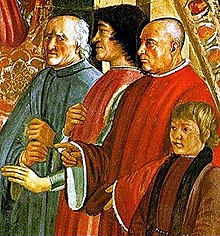
For most of the 13th century, the leading banking centre in Italy was Siena. But in 1298, one of the leading banking families of Europe, the Bonsignoris, went bankrupt, and the city of Siena lost its condition as the banking centre of Italian republic to Florence.[ten] Until the late 14th century, the leading family of Florence was the House of Albizzi. In 1293, the Ordinances of Justice were enacted; effectively, they became the constitution of the Commonwealth of Florence throughout the Italian Renaissance.[11] The urban center'south numerous luxurious palazzi were becoming surrounded by townhouses built by the prospering merchant class.[12]
The primary challengers to the Albizzi family were the Medici, first nether Giovanni di Bicci de' Medici, afterwards under his son Cosimo di Giovanni de' Medici and great-grandson, Lorenzo de' Medici. The Medici controlled the Medici Banking concern—then Europe'southward largest banking concern—and an array of other enterprises in Florence and elsewhere. In 1433, the Albizzi managed to have Cosimo exiled.[13] The side by side year, nonetheless, a pro-Medici Signoria (borough government) led by Tommaso Soderini, Oddo Altoviti and Lucca Pitti was elected and Cosimo returned. The Medici became the metropolis's leading family, a position they would hold for the next three centuries. Florence remained a republic until 1537, traditionally marking the end of the Loftier Renaissance in Florence, but the instruments of republican authorities were firmly under the control of the Medici and their allies, save during intervals after 1494 and 1527. Cosimo and Lorenzo rarely held official posts but were the unquestioned leaders.
The Medici family was continued to well-nigh other elite families of the fourth dimension through marriages of convenience, partnerships, or employment, so the family had a central position in the social network: several families had systematic admission to the residuum of the aristocracy families only through the Medici, mayhap similar to banking relationships. Some examples of these families include the Bardi, Altoviti, Ridolfi, Cavalcanti and the Tornabuoni. This has been suggested as a reason for the rise of the Medici family.[14]
Members of the family rose to some prominence in the early 14th century in the wool trade, particularly with France and Spain. Despite the presence of some Medici in the city's government institutions, they were still far less notable than other outstanding families such as the Albizzi or the Strozzi. Ane Salvestro de' Medici was speaker of the woolmakers' club during the Ciompi revolt of 1378–82, and one Antonio de' Medici was exiled from Florence in 1396.[xv] Involvement in some other plot in 1400 caused all branches of the family to be banned from Florentine politics for xx years, with the exception of two.
15th century [edit]
Giovanni di Bicci de' Medici (c. 1360–1429), son of Averardo de' Medici (1320–1363), increased the wealth of the family through his creation of the Medici Bank, and became one of the richest men in the city of Florence. Although he never held any political office, he gained strong pop back up for the family through his support for the introduction of a proportional system of revenue enhancement. Giovanni's son Cosimo the Elder, Pater Patriae (father of the state), took over in 1434 equally gran maestro (the unofficial head of the Florentine Republic).[sixteen]
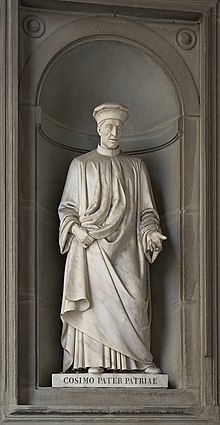
Cosimo Pater patriae, Uffizi Gallery, Florence
Three successive generations of the Medici—Cosimo, Piero, and Lorenzo—ruled over Florence through the greater part of the 15th century. They clearly dominated Florentine representative government without abolishing it altogether.[17] These three members of the Medici family had swell skills in the management of and then "restive and independent a urban center" as Florence. When Lorenzo died in 1492, notwithstanding, his son Piero proved quite incapable of responding successfully to challenges acquired by the French invasion of Italia in 1492, and within two years, he and his supporters were forced into exile and replaced with a republican government.[17]
Piero de' Medici (1416–1469), Cosimo'due south son, was only in power for five years (1464–1469). He was called "Piero the Gouty" because of the gout that pained his foot and led to his death. Dissimilar his father, Piero had little interest in the arts. Due to his illness, he mostly stayed at habitation bedridden, and therefore did niggling to further the Medici control of Florence while in power. Every bit such, Medici dominion stagnated until the next generation, when Piero's son Lorenzo took over.[18]
Lorenzo de' Medici (1449–1492), called "the Magnificent", was more capable of leading and ruling a city, but he neglected the family banking business, which led to its ultimate ruin. To ensure the continuance of his family's success, Lorenzo planned his children's future careers for them. He groomed the headstrong Piero II to follow as his successor in ceremonious leadership; Giovanni[19] (futurity Pope Leo X) was placed in the church at an early on age; and his daughter Maddalena was provided with a sumptuous dowry to make a politically advantageous spousal relationship to a son of Pope Innocent 8 that cemented the alliance between the Medici and the Roman branches of the Cybo and Altoviti families.[20]
The Pazzi conspiracy of 1478 was an try to depose the Medici family past killing Lorenzo with his younger brother Giuliano during Easter services; the bump-off effort ended with the death of Giuliano and an injured Lorenzo. The conspiracy involved the Pazzi and Salviati families, both rival banking families seeking to stop the influence of the Medici, as well as the priest presiding over the church services, the Archbishop of Pisa, and even Pope Sixtus IV to a degree. The conspirators approached Sixtus Iv in the hopes of gaining his approving, as he and the Medici had a long rivalry themselves, but the pope gave no official sanction to the plan. Despite his refusal of official approval, the pope notwithstanding immune the plot to proceed without interfering, and, after the failed assassination of Lorenzo, also gave dispensation for crimes done in the service of the church. After this, Lorenzo adopted his blood brother's illegitimate son Giulio de' Medici (1478–1535), the hereafter Pope Cloudless Seven. Lorenzo'due south son Piero II took over as the caput of Florence later on Lorenzo'southward death. The Medici were expelled from Florence from 1494 to 1512 after Piero acceded to all of the demands of invader Charles VIII of France.[21]
The Medici additionally benefited from the discovery of vast deposits of alum in Tolfa in 1461. Alum is essential every bit a mordant in the dyeing of certain cloths and was used extensively in Florence, where the main industry was fabric manufacturing. Before the Medici, the Turks were the only exporters of alum, so Europe was forced to buy from them until the discovery in Tolfa. Pius II granted the Medici family a monopoly on the mining there, making them the primary producers of alum in Europe.[22]
In the unsafe circumstances in which our urban center is placed, the time for deliberation is past. Action must be taken... I accept decided, with your approving, to sail for Naples immediately, believing that as I am the person confronting whom the activities of our enemies are importantly directed, I may, peradventure, by delivering myself into their hands, exist the ways of restoring peace to our fellow-citizens. Every bit I have had more honour and responsibleness amidst you lot than any individual denizen has had in our day, I am more leap than any other person to serve our state, even at the take chances of my life. With this intention I now go. Perhaps God wills that this war, which began in the blood of my brother and of myself, should be ended by whatever ways. My desire is that by my life or my death, my misfortune or my prosperity, I may contribute to the welfare of our metropolis... I become full of promise, praying to God to give me grace to perform what every denizen should at all times be ready to perform for his land.
— Lorenzo de' Medici, 1479.[23]
16th century [edit]
The exile of the Medici lasted until 1512, after which the "senior" branch of the family unit—those descended from Cosimo the Elder—were able to dominion until the bump-off of Alessandro de' Medici, first Duke of Florence, in 1537. This century-long dominion was interrupted just on two occasions (betwixt 1494–1512 and 1527–1530), when anti-Medici factions took control of Florence. Following the assassination of Knuckles Alessandro, power passed to the "junior" Medici branch—those descended from Lorenzo the Elder, the youngest son of Giovanni di Bicci, starting with his great-great-grandson Cosimo I "the Dandy."
Cosimo the Elder and his begetter started the Medici foundations in cyberbanking and manufacturing—including a form of franchises. The family'due south influence grew with its patronage of wealth, art, and civilization. Ultimately, information technology reached its zenith in the papacy and connected to flourish for centuries afterward as Dukes of Florence and Tuscany. At least half, probably more, of Florence's people were employed by the Medici and their foundational branches in business.
Medici popes [edit]

The Medici Hymeneals Tapestry of 1589
The Medici became leaders of Christendom through their ii famous 16th century popes, Leo 10 and Clement VII. Both also served as de facto political rulers of Rome, Florence, and large swaths of Italian republic known as the Papal States. They were generous patrons of the arts who commissioned masterpieces such every bit Raphael's Transfiguration and Michelangelo'due south The Last Judgment; however, their reigns coincided with troubles for the Vatican, including Martin Luther'southward Protestant Reformation and the infamous sack of Rome in 1527.
Leo 10'southward fun-loving pontificate bankrupted Vatican coffers and accrued massive debts. From Leo's ballot as pope in 1513 to his death in 1521, Florence was overseen, in turn, by Giuliano de' Medici, Duke of Nemours, Lorenzo de' Medici, Duke of Urbino, and Giulio de' Medici, the latter of whom became Pope Clement VII.
Clement VII'south tumultuous pontificate was dominated by a rapid succession of political crises—many long in the making—that resulted in the sack of Rome by the armies of Holy Roman Emperor Charles V in 1527 and rise of the Salviati, Altoviti and Strozzi equally the leading bankers of the Roman Curie. From the fourth dimension of Clement'due south ballot every bit pope in 1523 until the sack of Rome, Florence was governed by the young Ippolito de' Medici (future cardinal and vice-chancellor of the Holy Roman Church), Alessandro de' Medici (future duke of Florence), and their guardians. In 1530, after allying himself with Charles V, Pope Cloudless 7 succeeded in securing the engagement of Charles V's daughter Margeret of Republic of austria to his illegitimate nephew (reputedly his son) Alessandro de' Medici. Clement also convinced Charles V to name Alessandro as Duke of Florence. Thus began the reign of Medici monarchs in Florence, which lasted ii centuries.

Later on securing Alessandro de' Medici'southward dukedom, Pope Clement 7 married off his kickoff cousin, twice removed, Catherine de' Medici, to the son of Emperor Charles V's arch-enemy, Rex Francis I of France—the future King Henry Two. This led to the transfer of Medici claret, through Catherine'south daughters, to the royal family of Spain through Elisabeth of Valois, and the Business firm of Lorraine through Claude of Valois.
In 1534, following a lengthy illness, Pope Clement 7 died—and with him the stability of the Medici'due south "senior" branch. In 1535, Ippolito Cardinal de' Medici died under mysterious circumstances. In 1536, Alessandro de' Medici married Charles V's daughter, Margaret of Republic of austria; even so, the following year he was assassinated by a resentful cousin, Lorenzino de' Medici. The deaths of Alessandro and Ippolito enabled the Medici's "junior" co-operative to lead Florence.
Medici Dukes [edit]
Another outstanding figure of the 16th-century Medici family was Cosimo I, who rose from relatively modest ancestry in the Mugello to attain supremacy over the whole of Tuscany. Against the opposition of Catherine de' Medici, Paul III and their allies, he prevailed in diverse battles to conquer Florence's hated rival Siena and constitute the Grand Duchy of Tuscany. Cosimo purchased a portion of the island of Elba from the Republic of Genoa and based the Tuscan navy in that location. He died in 1574, succeeded by his eldest surviving son Francesco, whose expiry without male heirs led to the succession of his younger blood brother, Ferdinando, in 1587. Francesco married Johanna of Austria, and with his consort produced Eleonora de' Medici, Duchess of Mantua, and Marie de' Medici, Queen of France and Navarre. Through Marie, all succeeding French monarchs (bar the Napoleons) were descended from Francesco.
Ferdinando eagerly assumed the government of Tuscany. He commanded the draining of the Tuscan marshlands, built a road network in southern Tuscany and cultivated merchandise in Livorno.[24] To augment the Tuscan silk manufacture, he oversaw the planting of mulberry trees along the major roads (silk worms feed on mulberry leaves).[25] In foreign affairs, he shifted Tuscany away from Habsburg[26] hegemony by marrying the first not-Habsburg marriage candidate since Alessandro, Christina of Lorraine, a granddaughter of Catherine de' Medici. The Castilian reaction was to construct a citadel on their portion of the isle of Elba.[24] To strengthen the new Franco-Tuscan alliance, he married his niece, Marie, to Henry IV of French republic. Henry explicitly stated that he would defend Tuscany from Spanish aggression, merely afterwards reneged, afterwards which Ferdinando was forced to ally his heir, Cosimo, to Maria Maddalena of Republic of austria to assuage Spain (where Maria Maddalena'south sister Margaret was the incumbent Queen consort). Ferdinando also sponsored a Tuscan trek to the New World with the intention of establishing a Tuscan colony, an enterprise that brought no result for permanent colonial acquisitions.
Despite all of these incentives for economic growth and prosperity, the population of Florence at the dawn of the 17th century was a mere 75,000, far smaller than the other capitals of Italia: Rome, Milan, Venice, Palermo and Naples.[27] Francesco and Ferdinando, due to lax stardom between Medici and Tuscan country property, are thought to take been wealthier than their ancestor, Cosimo de' Medici, the founder of the dynasty.[28] The Chiliad Duke alone had the prerogative to exploit the state's mineral and common salt resource, and the fortunes of the Medici were straight tied to the Tuscan economy.[28]
17th century [edit]

Ferdinando, although no longer a cardinal, exercised much influence at successive conclaves. In 1605, Ferdinando succeeded in getting his candidate, Alessandro de' Medici, elected Pope Leo XI. He died the same month, but his successor, Pope Paul V, was likewise pro-Medici.[29] Ferdinando's pro-papal strange policy, however, had drawbacks. Tuscany was overrun with religious orders, non all of whom were obliged to pay taxes. Ferdinando died in 1609, leaving an flush realm; his inaction in international diplomacy, however, would take long-reaching consequences down the line.
In France, Marie de' Medici was interim equally regent for her son, Louis XIII. Louis repudiated her pro-Habsburg policy in 1617. She lived the remainder of her life deprived of any political influence.
Ferdinando's successor, Cosimo II, reigned for less than 12 years. He married Maria Maddalena of Austria, with whom he had his eight children, including Margherita de' Medici, Ferdinando Two de' Medici, and an Anna de' Medici. He is most remembered as the patron of astronomer Galileo Galilei, whose 1610 treatise, Sidereus Nuncius, was dedicated to him.[30] Cosimo died of consumption (tuberculosis) in 1621.[31]
Cosimo's elder son, Ferdinando, was not nonetheless of legal maturity to succeed him, thus Maria Maddalena and his grandmother, Christina of Lorraine, acted equally regents. Their collective regency is known every bit the Turtici. Maria Maddelana's temperament was analogous to Christina's, and together they aligned Tuscany with the papacy, re-doubled the Tuscan clergy, and allowed the heresy trial of Galileo Galilei to occur.[32] Upon the death of the concluding Knuckles of Urbino (Francesco Maria 2), instead of claiming the duchy for Ferdinando, who was married to the Duke of Urbino'southward granddaughter and heiress, Vittoria della Rovere, they permitted it to be annexed by Pope Urban Eight. In 1626, they banned whatever Tuscan subject from being educated exterior the Yard Duchy, a police force later overturned, simply resurrected past Maria Maddalena's grandson, Cosimo III.[33] Harold Acton, an Anglo-Italian historian, ascribed the decline of Tuscany to the Turtici regency.[33]
Thousand Duke Ferdinado was obsessed with new applied science, and had a variety of hygrometers, barometers, thermometers, and telescopes installed in the Palazzo Pitti.[34] In 1657, Leopoldo de' Medici, the Grand Duke'due south youngest blood brother, established the Accademia del Cimento, organized to attract scientists to Florence from all over Tuscany for mutual report.[35]
Tuscany participated in the Wars of Castro (the final time Medicean Tuscany proper was involved in a conflict) and inflicted a defeat on the forces of Pope Urban VIII in 1643.[36] The state of war endeavor was costly and the treasury and so empty because of information technology that when the Castro mercenaries were paid for, the state could no longer afford to pay interest on government bonds, with the result that the involvement charge per unit was lowered by 0.75%.[37] At that time, the economy was and then bedraggled that barter merchandise became prevalent in rural market places.[36]
Ferdinando died on 23 May 1670 afflicted by occlusion and dropsy. He was interred in the Basilica of San Lorenzo, the Medici'south necropolis.[38] At the time of his death, the population of the k duchy was 730,594; the streets were lined with grass and the buildings on the verge of collapse in Pisa.[39]
Ferdinando'southward matrimony to Vittoria della Rovere produced two children: Cosimo Iii de' Medici, Grand Duke of Tuscany, and Francesco Maria de' Medici, Knuckles of Rovere and Montefeltro. Upon Vittoria'southward death in 1694, her allodial possessions, the Duchies of Rovere and Montefeltro, passed to her younger son.
18th century: the fall of the dynasty [edit]
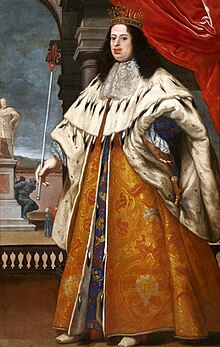
Cosimo Iii, the Medicean thou duke, in Grand Ducal regalia

Anna Maria Luisa de' Medici, the concluding of the Thousand Ducal line, in Minerva, Merkur und Plutus huldigen der Kurfürstin Anna Maria Luisa de' Medici (English: Minerva, Mercury and Pluto pay homage to the Electress Anna Maria Luisa de' Medici) afterwards Antonio Bellucci, 1706
Cosimo 3 married Marguerite Louise d'Orléans, a granddaughter of Henry Iv of France and Marie de' Medici. An exceedingly discontented pairing, this spousal relationship produced 3 children, notably Anna Maria Luisa de' Medici, Electress Palatine, and the last Medicean Yard Duke of Tuscany, Gian Gastone de' Medici.
Johann Wilhelm, Elector Palatine, Anna Maria Luisa's spouse, successfully requisitioned the dignity Royal Highness for the Thou Duke and his family in 1691, despite the fact that they had no claim to whatever kingdom.[twoscore] Cosimo often paid the Holy Roman Emperor, his nominal feudal overlord, exorbitant dues,[41] and he sent munitions to the emperor during the Battle of Vienna.
The Medici lacked male heirs, and past 1705, the yard ducal treasury was virtually bankrupt. In comparison to the 17th century, the population of Florence declined by fifty%, and the population of the k duchy every bit a whole declined by an estimated 40%.[42] Cosimo desperately tried to reach a settlement with the European powers, but Tuscany'southward legal status was very complicated: the expanse of the k duchy formerly comprising the Commonwealth of Siena was technically a Spanish fief, while the territory of the quondam Commonwealth of Florence was thought to be nether imperial suzerainty. Upon the death of his first son, Cosimo contemplated restoring the Florentine republic, either upon Anna Maria Luisa's expiry, or on his own, if he predeceased her. The restoration of the republic would entail resigning Siena to the Holy Roman Empire, but, regardless, information technology was vehemently endorsed past his government. Europe largely ignored Cosimo'due south plan. Only Nifty Great britain and the Dutch Republic gave whatsoever credence to it, and the programme ultimately died with Cosimo Iii in 1723.[43]
On four April 1718, United kingdom of great britain and northern ireland, French republic and the Dutch Democracy (also later, Austria) selected Don Carlos of Spain, the elder kid of Elisabeth Farnese and Philip V of Spain, as the Tuscan heir. By 1722, the electress was non even acknowledged as heiress, and Cosimo was reduced to spectator at the conferences for Tuscany's time to come.[44] On 25 Oct 1723, six days before his death, M Duke Cosimo disseminated a concluding proclamation commanding that Tuscany stay independent: Anna Maria Luisa would succeed uninhibited to Tuscany after Gian Gastone, and the grand duke reserved the correct to choose his successor. Nevertheless, these portions of his proclamation were completely ignored, and he died a few days after.
Gian Gastone despised the electress for engineering his catastrophic wedlock to Anna Maria Franziska of Saxe-Lauenburg; while she abhorred her brother'south liberal policies, he repealed all of his father'due south anti-Semitic statutes. Gian Gastone revelled in upsetting her.[45] On 25 Oct 1731, a Spanish detachment occupied Florence on behalf of Don Carlos, who disembarked in Tuscany in December of the same year. The Ruspanti, Gian Gastone's decrepit entourage, loathed the electress, and she them. Duchess Violante of Bavaria, Gian Gastone's sister-in-police, tried to withdraw the thou duke from the sphere of influence of the Ruspanti by organising banquets. His conduct at the banquets was less than regal; he often vomited repeatedly into his napkin, belched, and regaled those present with socially inappropriate jokes.[46] Following a sprained ankle in 1731, he remained bars to his bed for the rest of his life. The bed, often smelling of faeces, was occasionally cleaned by Violante.
In 1736, following the War of the Polish Succession, Don Carlos was disbarred from Tuscany, and Francis III of Lorraine was made heir in his stead.[47] In January 1737, the Spanish troops withdrew from Tuscany, and were replaced past Austrians.
Gian Gastone died on ix July 1737, surrounded past prelates and his sister. Anna Maria Luisa was offered a nominal regency by the Prince de Craon until the new grand knuckles could peregrinate to Tuscany, merely declined.[48] Upon her brother's death, she received all the House of Medici'south allodial possessions.
Anna Maria Luisa signed the Patto di Famiglia ("family pact") on 31 Oct 1737. In collaboration with the Holy Roman Emperor and 1000 Duke Francis of Lorraine, she willed all the personal holding of the Medici to the Tuscan state, provided that nothing was e'er removed from Florence.[49]
The "Lorrainers", as the occupying forces were called, were popularly loathed, merely the regent, the Prince de Craon, allowed the electress to live unperturbed in the Palazzo Pitti. She occupied herself with financing and overseeing the construction of the Basilica of San Lorenzo, started in 1604 past Ferdinando I, at a cost to the country of 1,000 crowns per week.[l]
The electress donated much of her fortune to charity: £4,000 a calendar month.[51] On 19 February 1743, she died, and the grand ducal line of the House of Medici died with her. The Florentines grieved her,[52] and she was interred in the crypt that she helped to consummate, San Lorenzo.
The extinction of the principal Medici dynasty and the accession in 1737 of Francis Stephen, Duke of Lorraine and hubby of Maria Theresa of Austria, led to Tuscany'due south temporary inclusion in the territories of the Austrian crown. The line of the Princes of Ottajano, an extant branch of the House of Medici who were eligible to inherit the grand duchy of Tuscany when the concluding male person of the senior branch died in 1737, could have carried on as Medici sovereigns but for the intervention of Europe's major powers, which allocated the sovereignty of Florence elsewhere.
As a event, the k duchy expired and the territory became a secundogeniture of the Habsburg-Lorraine dynasty. The outset grand duke of the new dynasty, Francis I, was a great-corking-keen-grandson of Francesco I de' Medici, thus he continued the Medicean Dynasty on the throne of Tuscany through the female person line. The Habsburgs were deposed in favor of the House of Bourbon-Parma in 1801 (themselves deposed in 1807), but were later restored at the Congress of Vienna. Tuscany became a province of the Britain of Italian republic in 1861. Still, several extant branches of the House of Medici survive, including the Princes of Ottajano, the Medici Tornaquinci,[53] and the Verona Medici Counts of Caprara and Gavardo.[54] (see Medici family tree)
Legacy [edit]
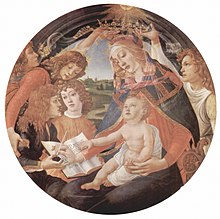
The greatest accomplishments of the Medici were in the sponsorship of fine art and compages, mainly early on and High Renaissance fine art and compages. The Medici were responsible for a high proportion of the major Florentine works of fine art created during their period of rule. Their back up was critical, since artists more often than not simply began piece of work on their projects after they had received commissions. Giovanni di Bicci de' Medici, the beginning patron of the arts in the family unit, aided Masaccio and commissioned Filippo Brunelleschi for the reconstruction of the Basilica of San Lorenzo, Florence, in 1419. Cosimo the Elder's notable artistic associates were Donatello and Fra Angelico. In later years, the most significant protégé of the Medici family was Michelangelo Buonarroti (1475–1564), who produced work for a number of family members, beginning with Lorenzo the Magnificent, who was said to be extremely addicted of the immature Michelangelo and invited him to study the family collection of antique sculpture.[55] Lorenzo also served equally patron to Leonardo da Vinci (1452–1519) for seven years. Indeed, Lorenzo was an artist in his own correct and an author of poetry and vocal; his support of the arts and letters is seen as a high point in Medici patronage.
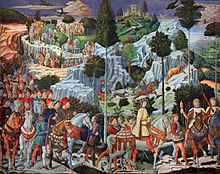
Medici family members placed allegorically in the entourage of a king from the Three Wise Men in the Tuscan countryside in a Benozzo Gozzoli fresco, c. 1459.
Subsequently Lorenzo's death, the puritanical Dominican friar Girolamo Savonarola rose to prominence, warning Florentines against excessive luxury. Under Savonarola's fanatical leadership, many peachy works were "voluntarily" destroyed in the Bonfire of the Vanities (Feb vii, 1497). The following yr, on 23 May 1498, Savonarola and ii young supporters were burned at the stake in the Piazza della Signoria, the aforementioned location as his bonfire. In add-on to commissions for art and architecture, the Medici were prolific collectors and today their acquisitions form the core of the Uffizi museum in Florence. In architecture, the Medici were responsible for some notable features of Florence, including the Uffizi Gallery, the Boboli Gardens, the Belvedere, the Medici Chapel and the Palazzo Medici.[56]
Later, in Rome, the Medici popes continued in the family tradition of patronizing artists in Rome. Pope Leo X would importantly commission works from Raphael, whereas Pope Clement 7 deputed Michelangelo to pigment the altar wall of the Sistine Chapel just earlier the pontiff'south death in 1534.[57] Eleanor of Toledo, a princess of Spain and married woman of Cosimo I the Great, purchased the Pitti Palace from Buonaccorso Pitti in 1550. Cosimo in turn patronized Vasari, who erected the Uffizi Gallery in 1560 and founded the Accademia delle Arti del Disegno – ("Academy of the Arts of Drawing") in 1563.[58] Marie de' Medici, widow of Henry Four of France and mother of Louis 13, is the field of study of a deputed bicycle of paintings known as the Marie de' Medici bicycle, painted for the Luxembourg Palace by courtroom painter Peter Paul Rubens in 1622–23.
Although none of the Medici themselves were scientists, the family is well known to have been the patrons of the famous Galileo Galilei, who tutored multiple generations of Medici children and was an of import figurehead for his patron's quest for power. Galileo'southward patronage was eventually abandoned by Ferdinando 2, when the Inquisition defendant Galileo of heresy. However, the Medici family did afford the scientist a safe haven for many years. Galileo named the iv largest moons of Jupiter after four Medici children he tutored, although the names Galileo used are not the names currently used.
Chief genealogical table [edit]
The tabular array below shows the origins of the Medici:
Medici Family unit Tree: Origins
This extract shows the branch that gave rise to the celebrated branch of the Medici descending from Giovanni "di Bicci", who founded the Medici fortunes:
This is the branch of Cosimo's blood brother, Lorenzo, called the "Popolano" Branch, which gave rise to the Thou-Dukes of Tuscany:
Titles [edit]
List of heads of the Medici [edit]
Signore in the Commonwealth of Florence [edit]
| Portrait | Proper noun | From | Until | Relationship with predecessor |
|---|---|---|---|---|
 | Cosimo de' Medici (Pater Patriae) | 1434 | 1 August 1464 | Son of Giovanni di Bicci de' Medici who was not as prominently involved in Florentine politics, rather more than involved in the financial area. |
 | Piero I de' Medici (Piero the Gouty) | 1 August 1464 | ii December 1469 | Eldest son of Cosimo de' Medici. |
 | Lorenzo I de' Medici (Lorenzo the Magnificent) | two December 1469 | ix April 1492 | Eldest son of Piero I de' Medici. |
 | Piero II de' Medici (Piero the Unfortunate) | 9 April 1492 | 8 Nov 1494 | Eldest son of Lorenzo the Magnificent. Overthrown when Charles VIII of France invaded as a total commonwealth was restored, outset nether the theocracy of Girolamo Savonarola and and so statesman Piero Soderini. |
 | Fundamental Giovanni de' Medici | 31 Baronial 1512 | 9 March 1513 | Blood brother of Piero the Unfortunate, second son of Lorenzo the Magnificent. Elected to the Papacy, becoming Pope Leo 10. |
 | Giuliano de' Medici, Duke of Nemours | 9 March 1513 | 17 March 1516 | Blood brother of Cardinal Giovanni de' Medici, third son of Lorenzo the Magnificent. |
 | Lorenzo II de' Medici, Duke of Urbino | 17 March 1516 | 4 May 1519 | Nephew of Giuliano de' Medici, Duke of Nemours, son of Piero the Unfortunate. Father of Catherine de' Medici, Queen consort of France. |
 | Key Giulio de' Medici | four May 1519 | xix November 1523 | Cousin of Lorenzo II de' Medici, Duke of Urbino, son of Giuliano de' Medici who was the brother of Lorenzo the Magnificent. Elected to the Papacy, becoming Pope Clement Seven. |
 | Key Ippolito de' Medici | 19 November 1523 | 24 October 1529 | Cousin of Cardinal Giulio de' Medici, illegitimate son of Giuliano de' Medici, Duke of Nemours. |
Dukes of Florence [edit]
| Portrait | Name | From | Until | Relationship with predecessor |
|---|---|---|---|---|
 | Alessandro il Moro | 24 October 1529 | six Jan 1537 | Cousin of Central Ippolito de' Medici, illegitimate son of Lorenzo 2 de' Medici, Duke of Urbino or Pope Clement 7. Interim signore during purple Siege of Florence, fabricated Duke in 1531. |
 | Cosimo I | 6 January 1537 | 21 April 1574 | Distant cousin of Alessandro de' Medici, Son of Giovanni dalle Bande Nere. dei Popolani line descended from Lorenzo the Elderberry, Blood brother of Cosimo de' Medici; too groovy-grandson of Lorenzo the Magnificent through his mother, Maria Salviati, and his grandmother, Lucrezia de' Medici. 1569, he was made Grand Duke of Tuscany. |
Grand Dukes of Tuscany [edit]
| Portrait | Name | From | Until | Relationship with predecessor |
|---|---|---|---|---|
 | Cosimo I | half dozen January 1569 | 21 April 1574 | |
 | Francesco I | 21 Apr 1574 | 17 October 1587 | Eldest son of Cosimo I de' Medici, Grand Knuckles of Tuscany. |
 | Ferdinando I | 17 Oct 1587 | 17 Feb 1609 | Blood brother of Francesco I de' Medici, Grand Duke of Tuscany, son of Cosimo I de' Medici, Grand Duke of Tuscany. |
 | Cosimo II | 17 Feb 1609 | 28 February 1621 | Eldest son of Ferdinando I de' Medici, Grand Duke of Tuscany. |
 | Ferdinando Ii | 28 February 1621 | 23 May 1670 | Eldest son of Cosimo II de' Medici, 1000 Duke of Tuscany. |
 | Cosimo 3 | 23 May 1670 | 31 October 1723 | Eldest son of Ferdinando Ii de' Medici, M Knuckles of Tuscany. |
 | Gian Gastone | 31 October 1723 | nine July 1737 | 2nd son of Cosimo III de' Medici, Grand Duke of Tuscany. |
Coats of arms [edit]
The origin of the Medici coat of arms is not recorded. One unproven story traces their ancestry to a knight of Charlemagne's, Averardo, who defeated a giant, Mugello. In reward, Charlemagne is said to have rewarded Averardo with the shield mauled by the giant, with the dents in the shape of assurance, and the behemothic'south lands in Mugello.
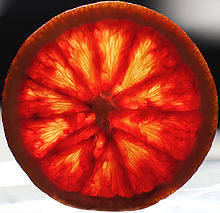
Here seen sliced in half, an fine art historian suggests that whole blood oranges could exist the imagery in the Medici coats of artillery
Another unproven theory suggests that represented coins copied from the coat of arms of the Guild of Moneychangers (Arte del Cambio) to which the Medici belonged. That shield was red strewn with Byzantine coins (bezants).[70] [71] The number of assurance also varied with time, as shown beneath. It has also been argued that these coins referenced the three coins or aureate balls associated with St. Nicholas, peculiarly as the saint was invoked by Italian bankers as they took oaths.[72]
As an Italian vocabulary word, "medici" ways "medical doctors" and identifications with the family members every bit physicians may be found among their names equally early on as the eleventh century. Fanciful stories draw the images as pills or cupping glasses, a belatedly-medieval medical instrument used to draw blood. Pills did not be until much latter and bloodletting was not in vogue at the time of the first Medici coat of arms. Fine art historian Rocky Ruggiero suggests plausibly even so, that the images may represent whole ripe claret oranges that typically are grown in Italia. Although knowledge of vitamins did non be at the time, the benefit of oranges for certain diseases was recognized and their association with recommendations by medical doctors suggests to Dr. Ruggiero that this likely is the imagery intended in the coats of arms for the Medici family unit.[73]
-

Old coat of arms of the Medici used past Giovanni di Bicci and Cosimo the Elder
-

The intermediate glaze of arms of the Medici, Or, six assurance in orle gules
-

The "augmented coat of arms of the Medici, Or, five balls in orle gules, in master a larger ane of the artillery of France (viz. Azure, three fleurs-de-lis or) was granted past Louis 11 in 1465.[1]
-
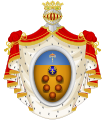
Great coat of arms of Medici of Ottajano
-

Augmented Arms of Medici
-

Coat of Artillery of the K-Duke of Tuscany
-

Glaze of arms of Medici popes
-

Coat of arms of the Medici Cardinals
-

Coat of Arms of Catherine of Medici, equally Queen of France
-

Coat of Artillery of Maria of Medici, as Queen of France
-

Achievement of the House of de' Medici
-
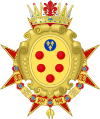
Coat of Arms of the Grand-Duchy of Tuscany
See also [edit]
- Medici family tree
- List of popes from the Medici family unit
- Strozzi family (surviving), Pazzi family unit (extinct) rivals of the Medici
- Castellini Baldissera family (relatives of the Medici)
Notes [edit]
- ^ a b John Woodward, A Treatise on Ecclesiastical Heraldry, 1894, p. 162
- ^ Litta, Pompeo (1827). Famiglie celebri italiane. Medici di Firenze.
- ^ Luisa Greco (22 May 2015). "Cosimo de Medici e l'amore per le tartarughe con la vela". Toctoc.
- ^ "Medici". CollinsDictionary.com. HarperCollins. Retrieved 12 Feb 2020.
- ^ The family of Pius Four, the Medici of Milan, considered itself a branch of the Firm of Medici and was recognized as such by the Florentine Pope Clement 7 and by Cosimo I 'de Medici in the early 16th century. Historians take constitute no proof of an actual connection between the Medici of Milan and the Medici of Florence, but this belief was widespread during the life of Pius Four and the Medici of Florence allowed the Medici of Milan to use their coat of arms.
- ^ "Medici Family – – Encyclopædia Britannica". Encyclopædia Britannica . Retrieved 27 September 2009.
- ^ Malaguzzi, Silvia (2004). Botticelli. Ediz. Inglese. Giunti Editore. ISBN9788809036772 – via Google Books.
- ^ The Medieval World – Europe 1100–1350 by Friedrich Heer, 1998 Germany
- ^ The name in Italian is pronounced with the stress on the beginning syllable /ˈmɛ .di.tʃi/ and not on the second vowel.How to say: Medici, BBC News Magazine Monitor—MED-uh-chee in American English.
- ^ Strathern, p 18
- ^ Kenneth Bartlett, The Italian Renaissance, Chapter vii, p. 37, Book Two, 2005.
- ^ "History of Florence". Aboutflorence.com. Retrieved 2015-01-26 .
- ^ Crum, Roger J. Severing the Cervix of Pride: Donatello's "Judith and Holofernes" and the Recollection of Albizzi Shame in Medicean Florence . Artibus et Historiae, Volume 22, Edit 44, 2001. pp. 23–29.
- ^ Padgett, John F.; Ansell, Christopher Thousand. (May 1993). "Robust Action and the Ascension of the Medici, 1400–1434" (PDF). The American Journal of Sociology. 98 (6): 1259–1319. doi:10.1086/230190. JSTOR 2781822. S2CID 56166159. Archived from the original (PDF) on 2020-03-03. . This has led to much more than analysis.
- ^ Machiavelli, Niccolò (1906). The Florentine history written past Niccolò Machiavelli, Volume 1. p. 221. .
- ^ Bradley, Richard (executive producer) (2003). The Medici: Godfathers of the Renaissance (Part I) (DVD). PBS Dwelling Video.
- ^ a b The Prince Niccolò Machiavelli. A Norton Critical Edition. Translated and edited by Rober 1000. Adams. New York. West.Due west. Norton and Visitor, 1977. p. eight (Historical Introduction).
- ^ Ulwencreutz, Lars (2013). Ulwencreutz'south The Imperial Families in Europe V. ISBN9781304581358 . Retrieved 20 September 2018.
- ^ 15th century Italy.
- ^ Hibbard, pp. 177, 202, 162.
- ^ Hibbert, Christopher (1974). The House of Medici: Its rise and autumn. New York: William Morrow and Company. ISBN0-688-00339-seven. OCLC 5613740.
- ^ Halvorson, Michael (2014). The Renaissance: All That Matters. Hodder & Stoughton. ISBN9781444192964.
- ^ Hibbert, The House of Medici: Its Rise and Fall, 153.
- ^ a b Hale, p. 150.
- ^ Hale, p. 151.
- ^ Austria and Kingdom of spain were ruled by the House of Habsburg; the two are interchangeable terms for the Habsburg domains in the time menstruum in question.
- ^ Hale, p. 158.
- ^ a b Unhurt, p. 160.
- ^ Hale, p. 165.
- ^ Strathen, p. 368.
- ^ Unhurt, p. 187.
- ^ Acton, p. 111.
- ^ a b Acton, p. 192.
- ^ Acton, p. 27.
- ^ Acton, p. 38.
- ^ a b Hale, p. 180.
- ^ Hale, p. 181.
- ^ Acton, p. 108.
- ^ Acton, p. 112.
- ^ Acton, p. 182.
- ^ Acton, p. 243.
- ^ Strathern, p. 392.
- ^ Hale, p. 191.
- ^ Acton, p. 175.
- ^ Acton, p. 280.
- ^ Acton, p. 188.
- ^ Acton, p. 301.
- ^ Acton, p. 304.
- ^ "Anna Maria Luisa de' Medici – Electress Palatine". Retrieved 3 September 2009.
- ^ Acton, p. 209.
- ^ Acton, p. 310.
- ^ Acton, p. 309.
- ^ Florence Journal; Where the Bodies Are Cached, Modern-Day Medici Feud, Alan Feuer, New York Times, May 4, 2004
- ^ Hibbert, p. 60.
- ^ Howard Hibbard, Michelangelo (New York: Harper and Row, 1974), p. 21.
- ^ Peter Barenboim, Sergey Shiyan, Michelangelo: Mysteries of Medici Chapel, SLOVO, Moscow, 2006. ISBN 5-85050-825-2
- ^ Hibbard, p. 240.
- ^ Official site of the Accademia delle Arti del Disegno of Florence, Brief History (it. leng.)"Archived copy". Archived from the original on 2009-06-03. Retrieved 2009-06-01 .
{{cite web}}: CS1 maint: archived copy as championship (link) - ^ Ii more than sons: Arrigo (?-?), Giovanni (?-?)
- ^ Three more sons: Talento (?-?), he had a son, Mario died in 1369, Mario had few unremarkable later generations; Jacopo (?-1340) who had a son, Averardo (fl. 1363); Francesco (?-?), who had a son, Malatesta died in 1367.
- ^ Four sons: Guccio (from which descended a line extinct in 1670 with Ottaviano), Filippo (?-?), Betto (fl. 1348), Ardinghello (fl. 1345).
- ^ One more son: Giovanni (fl. 1383). Giovanni had a son, Antonio (?-1396) and a nephew, Felice (?-?).
- ^ One son, Coppo, (?-?). Cfr. Mecatti, Giuseppe Maria; Muratori, Lodovico Antonio (1755). Storia cronologica della città di Firenze (in Italian). Vol. Parte prima. Naples: Stamperia Simoniana. p. 157. Retrieved March 28, 2016.
- ^ Two more brothers unknown.
- ^ 2 more than brothers: Andrea (*? †?), Bartolomeo (*? †?).
- ^ One more than brother: Pietro (*? †?), line extinct.
- ^ One more than blood brother: Giovanni (*? †?)
- ^ I more than son: Francesco (†1552?)
- ^ One more son Bernardo (†1592?)
- ^ de Roover, Raymond (31 July 2017). The Medici Banking company: Its Arrangement, Management, Operations, and Decline. Pickle Partners Publishing. pp. annotation ane.
- ^ Mackworth-Young, Rose (29 March 2012). "The Medici balls: Origins of the family's glaze of arms". The Florentine. Florence: B'Gruppo Srl (160). Retrieved 17 Oct 2017.
- ^ Clare, Edward Thousand. (1985). St. Nicholas: His Legends and Iconography. Florence: Leo S. Olschki. p. 76.
- ^ Ruggiero, Rocky, Ph.D., Rebuilding The Renaissance, Episode 93 – Florence: The Medici Dynasty, Making Art and History Come up to Life, October 28, 2020, an audio file
References [edit]
- Hibbert, Christopher (1975). The House of Medici: Its Rise and Fall . Morrow. ISBN0-688-00339-seven. a highly readable, non-scholarly general history of the family unit
- Miles J. Unger, Magnifico: The Brilliant Life and Tearing Times of Lorenzo de Medici, (Simon and Schuster 2008) is a vividly colorful new biography of this true "renaissance human", the uncrowned ruler of Florence during its gilded age
- Ferdinand Schevill, History of Florence: From the Founding of the Metropolis Through the Renaissance (Frederick Ungar, 1936) is the standard overall history of Florence
- Cecily Berth, Cosimo I, Duke of Florence, 1921, Academy Printing
- Harold Acton, The Last Medici, Macmillan, London, 1980, ISBN 0-333-29315-0
- Paul Strathern, The Medici—Godfathers of the Renaissance (Pimlico, 2005) is an informative and lively account of the Medici family, their finesse and foibles—extremely readable, though with a few factual and typographical errors.
- Lauro Martines, Apr Blood—Florence and the Plot Against the Medici (Oxford Academy Press 2003) a detailed business relationship of the Pazzi Conspiracy, the players, the politics of the twenty-four hour period, and the fallout of the assassination plot . Though accurate in celebrated details, Martines writes with a definite 'anti-Medici' tone.
- Accounting in Italy
- Herbert Millingchamp Vaughan, The Medici Popes. New York: Chiliad.P. Putnam's Sons, 1908.
- Jonathan Zophy, A Brusque History of Renaissance and Reformation Europe, Dances over Fire and H2o. 1996. 3rd ed. Upper Saddle River, New Bailiwick of jersey: Prentice Hall, 2003.
- Villa Niccolini (Camugliano), Villa Niccolini, is one of the Medici'south tuscany villa previously called Villa Medicea di Camugliano, Villa Niccolini is located due east from Ponsacco, near a piffling feudal village, Camugliano.
Further reading [edit]
- Jean Lucas-Dubreton, Daily Life in Florence in the Fourth dimension of the Medici.
- Danny Chaplin, "The Medici: Ascension of a Parvenu Dynasty, 1360–1537."
External links [edit]
- The Medici Archive Project
- Prince Ottaviano de' Medici: Solving a 417-year-old murder mystery (May 4, 2004)
- The Moscow Florentine Society
- Medici Family Tree, featuring portraits and bios of key members of the Medici Dynasty, 1400–1737
- The Medici Family, History Channel. Retrieved eight April 2016. The Medici Family
- The Medici Family of Florence
Source: https://en.wikipedia.org/wiki/House_of_Medici
0 Response to "The Family Medici: the Hidden History of the Medici Dynasty Pdf"
Post a Comment